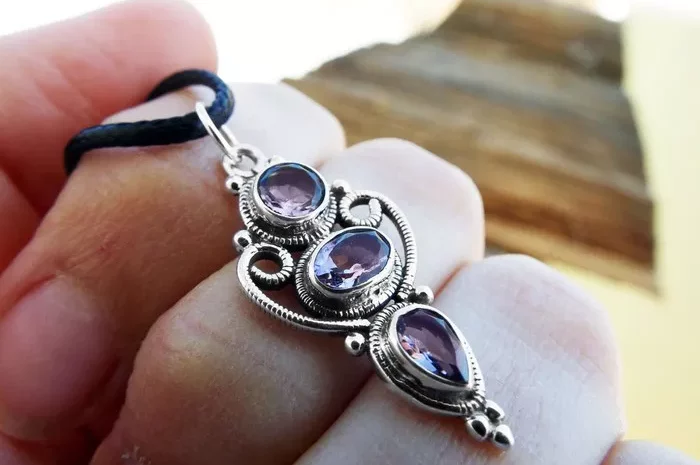Amethyst, a member of the Quartz family, is a gemstone renowned for its captivating shades of purple. Its name derives from the Greek word “amethystos,” meaning “not drunk” or “not intoxicated,” hinting at its historical association with sobriety and clarity. This beautiful gemstone has fascinated humans for centuries, not only for its aesthetic appeal but also for the myriad beliefs and legends surrounding it. In this article, we will explore the formation of amethyst rock in a detailed, subtitled, and popular science style.
Chemical Composition and Classification
Amethyst is primarily composed of Silicon Dioxide (SiO2), with trace amounts of Ferric Iron (Fe2O3) responsible for its distinctive purple hues. It belongs to the silicate minerals, specifically the tectosilicates subclass, and the Quartz group. Quartz itself is a widespread mineral found in various rock types, with amethyst being a variety distinguished by its color.
Geological Environment and Formation Process
Origin in Silica-Rich Environments
Amethyst forms in silica-rich liquids that are deposited in gas cavities, known as geodes, within lava or volcanic rocks. These geodes are essentially hollow spaces filled with mineral-laden waters that, over time, crystallize into various minerals, including Quartz. When the conditions are favorable, Quartz crystals begin to grow within these geodes, and if trace elements like iron are present, the crystals can take on the purple hue of amethyst.
Crystal Growth and Morphology
Quartz crystals, including amethyst, often grow in hexagonal prisms, a shape dictated by the mineral’s crystal structure. These crystals can form singly or in clusters, with amethyst commonly occurring as drusy masses, where numerous small crystals are packed tightly together. The drusy appearance is characterized by the rhombic terminations of the Quartz crystals, creating a sparkling effect on the surface of the rock.
Heat Sensitivity and Color Change
An interesting aspect of amethyst is its sensitivity to heat. When heated to high temperatures, amethyst can lose its purple color and transform into yellow Citrine. This property is often exploited in the gemstone industry to produce commercial Citrine. However, natural Citrine, which forms without artificial heating, is rare and highly valued. In some cases, natural amethyst and Citrine can grow together within the same crystal, creating a unique gemstone known as Ametrine, which displays alternating bands of purple and orange/yellow.
Natural Occurrences and Mining
Worldwide Distribution
Amethyst is found worldwide, with notable deposits in various countries including Brazil, Uruguay, Bolivia, Russia, Sri Lanka, and the United States. Each deposit has its unique characteristics, such as color intensity and crystal habit, which can affect the value and appeal of the gemstones produced.
Mining Techniques
Mining amethyst typically involves opening up geode-bearing rock formations and extracting the geodes. Once extracted, the geodes are carefully opened to reveal the crystals within. The crystals are then cleaned, cut, and polished to bring out their natural beauty and clarity.
Legends and Beliefs
Throughout history, amethyst has been associated with various legends and beliefs. In ancient Greece, it was believed to prevent intoxication and was often worn by wine-loving gods and mortals. This belief may have stemmed from the gemstone’s name, which translates to “not drunk.” Additionally, amethyst was thought to have healing properties and was used in jewelry and amulets to protect against illness and evil spirits.
In modern times, amethyst remains a popular gemstone, not only for its beauty but also for its symbolic meaning. Many people believe it promotes calmness, clarity, and spiritual awareness, making it a favorite among those seeking balance and inner peace.
Scientific Understanding and Modern Applications
Color Origin
The purple color of amethyst is the result of trace amounts of iron impurities within the Quartz crystal structure. During the crystallization process, iron atoms substitute for silicon atoms in the Quartz lattice, creating small defects that absorb visible light in the yellow-green region of the spectrum. The absorbed light is then re-emitted as purple light, giving the gemstone its characteristic color.
Optical Properties
Amethyst exhibits a vitreous (glassy) luster and is transparent to translucent, allowing light to pass through while scattering it in a beautiful manner. Its hardness of 7 on the Mohs scale makes it suitable for use in jewelry, as it can withstand everyday wear and tear.
Jewelry and Decorative Arts
Due to its beauty and durability, amethyst is widely used in jewelry and decorative arts. It can be found in rings, necklaces, bracelets, earrings, and other accessories. Its rich purple hues complement a variety of outfits and styles, making it a versatile choice for both everyday wear and special occasions.
Healing Crystals and Metaphysical Beliefs
While the scientific community may not fully endorse the healing properties of amethyst, many people still believe in its metaphysical benefits. It is often used in crystal healing practices to promote relaxation, reduce stress, and improve overall well-being.
Conclusion
In conclusion, amethyst is a fascinating gemstone formed through the natural processes of crystallization within silica-rich environments. Its unique purple color, hardness, and luster make it a popular choice for jewelry and decorative arts. Despite its long history and association with various legends and beliefs, the scientific understanding of amethyst’s formation and properties continues to evolve. Whether worn for its beauty, its symbolic meaning, or its potential healing properties, amethyst remains a cherished gemstone in the hearts of many.
Related topic:
- What Determines the Value of an Amethyst?
- How Can You Tell if Amethyst Is Natural or Synthetic?
- Lighter Amethyst Vs Darker Amethyst :Which Is More Valuable?


